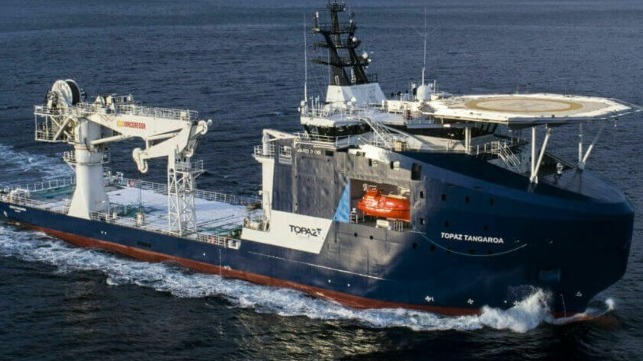UK Acquires CSOV to Launch Subsea Protection Mission

The UK’s Royal Fleet Auxiliary is set to take delivery in the next few days on the first of two vessels designed to support offshore subsea construction to initiate the Ministry of Defense’s new mission to patrol and protect key subsea assets. British Prime Minister Rishi Sunak has made the program one of his priorities citing the national security nature of the assets after the apparent sabotage of the Nord Stream pipeline in 2022.
Sunak authored a study on the vulnerability of subsea cable infrastructure to foreign espionage and sabotage in 2017. The report highlighted that just over 200 subsea cables carry about 97 percent of the world's telecommunications, along with trillions of dollars in financial transactions each year. After taking office last fall, the Prime Minister canceled his predecessor's plans for a grand national flagship saying instead the funds would be used to accelerate the launch of the surveillance program for the subsea assets.
Defense Secretary Ben Wallace announced that the first of the two acquired vessels, a 2019 built CSOV named Topaz Tangaroa arrived at the Cammell Laird shipyard in Birkenhead near Liverpool earlier today, January 19. The vessel which is nearly 322 feet long and 3,000 dwt was built by Vard for Topaz Energy and Marine. According to the shipyard, the Topaz Tangaroa was specially designed and equipped for subsea operation duties with a high focus on good sea-keeping abilities, excellent station-keeping performance, and low fuel consumption.
The Ministry reports the vessel was selected to meet the requirements of the Royal Navy and has critical features including a helipad, crane, expansive working deck, and most importantly a large access point in the hull through which submersibles can be launched. They believe the vessel can be easily adapted from its original role which was to support operations at oil rigs, including undersea construction, maintenance, and inspection work due to its design for autonomous submarine operations and supporting submersible operations.
“This is an entirely new mission for the Royal Fleet Auxiliary,” notes Commodore David Eagles, Head of the Royal Fleet Auxiliary. “We have been entrusted with supporting a key operation to safeguard the UK’s infrastructure, security and prosperity and that fills all of us in the RFA with pride.”
The program is ahead of schedule having been accelerated by the Prime Minister and Ministry of Defense from its original launch set for 2024. During its stay at Cammell Laird, the ship will be repainted and have critical military equipment installed, as well as be renamed. The vessel which is officials being called the first of two Multi-Role Ocean Surveillance (MROS) ships is expected to enter operational service in the summer of this year.

that matters most
Get the latest maritime news delivered to your inbox daily.
Once operational, the ship will be dedicated to safeguarding seabed telecommunications cables and oil and gas pipelines. The vessel will be crewed by around two-dozen RFA sailors, while around 60 Royal Navy specialists will operate the undersea surveillance systems and other survey and warfare systems.
The Ministry of Defense reports the acquisition of a second ship is currently in the concept phase, although the independent media outlet Navy Lookout believes the ship has been identified. They expect a smaller vessel, the 4,600 dwt Island Crown, will shortly be added to the program. Designed as an accommodation vessel, the media outlet speculates that it will serve in the RFA in support of mine countermeasures tasks around the UK and in European waters.
